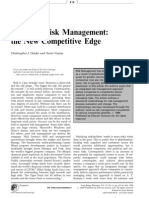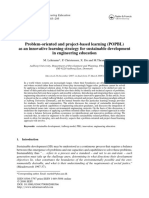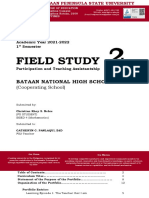Professional Documents
Culture Documents
Denver 1-Trupti Patil
Denver 1-Trupti Patil
Uploaded by
Trupti PatilOriginal Description:
Original Title
Copyright
Available Formats
Share this document
Did you find this document useful?
Is this content inappropriate?
Report this DocumentCopyright:
Available Formats
Denver 1-Trupti Patil
Denver 1-Trupti Patil
Uploaded by
Trupti PatilCopyright:
Available Formats
DENVER AIRPORT AUTOMATED BAGGAGE SYSTEM - FAILED PROJECT
PROJECT CONCEPTION: The vision was to implement the largest automated baggage handling system the world had seen and allows Denver International Airport to be hailed as the air transportation hub, the largest in the United States with a capacity to handle more than 50 million passengers annually. The Denver Baggage system was to be a work of efficiency and cost effectiveness. The project was to originally automate baggage transportation throughout the airport and in the end save money for the airport. The airport's computerized baggage system, was supposed to reduce delays, shorten waiting times at luggage carousels, and cut airline labor costs. The concept of automated baggage system came to satisfy need for greater airport capacity and mainly to cement Denvers position as an AIR TRANSPORT HUB. The projects objective was automating baggage handling, aircraft turnaround time was to be reduced to as little as 30 minutes.
PROJECT DEFINITION:
The new Denver International Airport (DIA) is spread over 50 square miles and has the capacity to expand to 12 runways. Because of the size of the airport, planners decided to build a state-of-the-art automated baggage handling system to move bags much more quickly than the conventional tugand-cart/conveyor system. Covering a land area of 140km2, the airport was to be the largest in the United States and have the capacity to handle more than 50m passengers annually. Cost estimates for completion of the airport, derived from analysis done in September 1989, totaled about $4.9 billion and the project will be considered
to complete with in time limit of 2 years. This was great idea and in theory would have saved the airport millions in labor costs and fees. PROJECT PLANNING: In summer 1991 Airports project management team recognizes that a baggage handling solution for the complete airport was required. Bids for an airport wide solution are requested. The plan was to use the system as a hub and streamline all their baggagehandling needs. The system was to include an extensive networking system of computers that would automatically send baggage to the correct over a mile wide space. PROJECT LAUNCH AND EXECUTION: In Feb 1991, Continental Airlines signs on and plans on using Denver as a Hub. In Jun 1991, United Airlines signs on and plans on using concourse A as a Hub. After this united Airlines engaged BAE system to build an automated baggage system for concourse A. Two years into the construction of the airport, DIA planners decided that an integrated baggage handling system would further improve the efficiency of the airport for all passengers. When the other airlines did not plan for their baggage systems DIA sent out requests for bids. Of 16 companies contracted, only three responded. All of these were rejected by the consulting firm hired by DIA on the grounds that their plans would not meet the airports needs. Denver Project Management team approach BAE directly requesting a bid for the project by making contracts to expand the United Airlines baggage handling system into an integrated system handling all 3 concourses, all airlines, departing as well as arriving flights. Contract is hammered out in 3 intense working sessions. United Airlines changes their plans and cuts out plans for the system to
transfer bags between aircrafts. Resulting changes saved $20m. The Airports project management team changed their strategy by realizing that if an integrated system was to be built, they needed to take responsibility back from the individual airlines and run project themselves. Because of which project Management Team was the only central group that could run the project. Both the airport Project Management team and BAE decided to proceed with the full scale project. The decisions to proceed was based on the communications between the airports Chief Engineer, Walter slinger and BAEs senior management team.BAE had initially chosen not to bid for the airport wide contract, the rejection of three official bids resulted in the airport team speaking directly to BAE about the possibility of expanding the United Airlines system that was already under development. Those discussions resulted in the preparation of specification and creation of a large scale prototype. Demonstration of the prototype is said to have been the factor that convinced Slinger that the system was feasible. Both BAE and Slinger will have recognized that they were working within a tight time frame and the pressure to move quickly may have caused them to put due diligence to one side. The belief was that, due to airports size, a manual system would not be fast enough to meet aircraft turnaround requirements. BAE committed to deliver the complete system under a fixed scope, schedule and budget arrangement. They had been more aware that they almost certainly would have taken steps to limit the risk and to find ways to limit the scope to something that was more achievable in the time available. The 3 working sessions will not have provided sufficient time for the different parties to develop an in-depth understanding of what was involved or for them to fully understand the risks they were taking. Although the airlines were key stakeholders in the system they were excluded from the discussions. As, they usually ask for significant changes that can negate much of the previous work done on the project. BAE had made it a condition that no changes would be made, the pressure to meet stakeholder needs proved to be too strong and BAE & ai rports Project Management team were forced into accepting them.
The major changes done were; The addition of ski equipment tracks The addition of maintenance tracks, to allow carts to be serviced without being removed from rails and changes to the handling of oversized baggage. The design of building was started before the baggage system design was known, the designers of the physical building only made general allowances for where they thought the baggage system would go. When the baggage system design was eventually started, the baggage system design team was forced to work within the constraints left to them by the designers of the physical building. PROJECT EVALUATION AND CLOSURE: Significant mechanical and software problems plagued the baggage system during system tests: bags were misloaded, misrouted, or fell out of telecasts, causing the system to jam. The automated baggage handling system that was to provide unified handling of baggage for all airlines contributed to a delay in the opening of the $4.2 billion airport by 16 months. Instead of opening in October of 1993, as planned, the faulty baggage handling system delayed that date until February 28, 1995. The delay cost both airlines and the city of Denver roughly $1 million dollars per day. The project soon became evident to be very untrue and unrealistic. The biggest issue with this way of thinking, there was no plan B in the process. When planning a large scale project the impossible can happen and the worst outcomes can easily become an issue. The first thing in project management is that one must figure out how to streamline a project to completion the most effective way possible but also prepare for the unknown. Those in charge of the Denver system clearly were not successful project mangers due to their failure in planning. Millions more have been spentsince in repairs and modifications.
The opening of the actual airport was delayed numerous times. These being between Feb. 1993 to April 1994. This was due to the project not sticking to schedules and construction delays. The biggest issue was that the project management teams were more interested in getting fame and credit for making this amazing system while not evaluating the true possibility that it could fail and that it was predicted it was to fail. The management team had a four year window to plan, construct and produce this system and exceeded to fail in all of those objectives. The project was of too much money, originally over 61 million dollars it was an extremely high risk project for a local government to put such a large amount of income into. Even with outside investing it seemed that United and the city of Denver were the biggest losers. The change in leadership was apparent and within that time frame many project leaders changed and the vision moved so that caused inconsistency. Consequently, the software was more difficult to develop and test. As planned, the system was the most complex baggage system ever attempted. It was 10 times larger than any other automated systems; the increased size resulted in an exponential growth in complexity mainly because of line balancing. Failure to anticipate number of carts correctly would result on delays in picking up bags that would undermine systems performance goals. The time decided for project completion was insufficient because of which many of the projects subsequent problems were likely a result of shortcuts the team took and the mistakes they made as they tried to meet an impossible schedule. Because of changes made in existing strategy, time frame got affected. Project management team was failed to see that the shift in technology required a corresponding shift in organizational responsibilities. The failure to recognize that shift represents a planning failure that dated back to the very start of the construction project. Again the next major problem was related to design of physical buildings structure. Designers of the physical building did not worked along with the people who had expertise in designing baggage systems.
IMPORTANT STAKEHOLDERS: 1) Project Management team 2) Airports chief engineer Mr. Walter Slinger 3) United Airlines 4) Continental Airlines 5) BAEs Senior management team 6) Baggage designing system team 7) Designers of physical building 8) Designers of baggage systems 9) Mayer of Denver 10) BAEs managers 11) Mattias Franz of Logplan Consulting of Germany(a specialist in the design and construction of baggage handling systems) COMMUNICATION: A properly managed communication plan can positively affect a project success and reduce risk impact. Clearly, management failed to create a reasonable and consistent level of communication between all the stakeholders involved. There was no evidence that management even attempted to understand the magnitude of their problem until the postponed opening of the airport. Denver Airport project team should have had consistent meetings with all the stakeholders involved in the project to notify them all whenever there is a change to the project with a clear presentation of the changes, progress or next stage of the project. Also, a central tracking database system should have been maintained to produce an integrated report that stakeholders of the project would have had access to for up-to-date information or reminders. For example, in Heathrow T5 meeting with all the stakeholders were always having meetings. Visual languages were used to represent and present information. 2D images and3D models were used to give a more realistic way of the project rather than abstract concepts.
Communication channels between the city, project management team, and consultants degraded and became disorganized. In fact, communication and debate between the various project managers and among the subcontractors was neither encouraged nor facilitated. BAE had never created a baggage system this complex before. The risks were enormous. Certainly the choice of 486-based PCs, operating under DOS, and networked together using additional third party software, was a major contributor to the systems failure. The poor management and lack of due diligence and communications breakdown made the legendary baggage system unfeasible in case of Denver Airport case. This oversight between the two partners (BAE and DIA) caused the Colorado taxpayers to lose millions of dollars in revenue. Communication measures between the project team, consultants and city were not controlled or well-defined. For example when the filters for electricity were ordered, a city worker cancelled it without the knowledge of the filters being a part of the project. The filters finally arrived later sometime in March 1994.The major project the project faced was when, Walter Slinger who was the systems de facto sponsor died in October 1992. RISK MANAGEMENT: Properly managed risk reduces or removes the risk that can threaten the achievement of project objectives. Risk management is an essential part of project management because unmitigated or unmanaged risk can cause a project to fail. Denver officials should have developed a questionnaire and send out to all the companies that would be part of the project and the contractors would have provide evidence to their answers. This would have determined the competence of contractors. BAE should have accepted the risk of the project so the contractors would have confidence in carrying out their tasks. There should have been a good backup system such as the tugs and carts that can carry large baggage and access roads should have been created between
check-in and aircraft. For example, Terminal 5 in Heathrow London, BAA who is in charge of the project accepted the risk for the project which removed the issue of accountability from the suppliers and contractors. This disallowed an unproductive culture of confrontation and blame. The smooth running of T5 was facilitated by a software system called Project Flow ordered the requests for materials and ensures they were supplied as needed and on time. BAE, the company that designed and implemented the system never created a system of this scale before, so the risks were high and were not given enough time to build the system, reason why BAE overlooked many details and needed IT infrastructure. The Rapid Application Development (RAD) methodology, also called rapid prototype couldve have work successfully in DIA. A smaller baggage system prototype couldve been the answer to succeed in this megaproject by reducing inherent project risks. Another problem was that experts advice was ignored and they did not know the volume of uncertainty they were going to encounter else precautionary measures would have been taken to reduce the risk. A properly managed communication plan can positively affect a project success and reduce risk impact. Means in this case planning was not good enough.
A smaller baggage system prototype couldve been the answer to succeed in this megaproject by reducing inherent project risks. While most prototypes are developed with the expectation that they will be discarded it is possible in some cases to evolve from prototype to a working system and DIA had definitely this possibility. BAE couldve evolved this mega-system through development, modification and implementation of small prototype. DIA baggage system was a time-critical project and the construction of an evolutionary prototype; they couldve delivered in the long run a high quality system at a relatively low investment cost. In other words, BAE
couldve fulfilled DIA business needs and satisfy end-users while perfecting the system overtime. Among the 4 processes according to us, Project Planning is the mail cause of success or failure of the project.
CONCLUSION: Defining project failure is a very complicated issue to address because there are some unavoidable situations that could make a project cancelled such as; changing business objectives, making significant cultural or operational change etc. Different people have differing views about this issue. Just because a project is not completed within budget and time does not mean that the project is a failure. A project can still be a success even with the failing of the project management if it meets with the long term objectives. If a project is not delivered within specified budget, schedule and quality it is not the project that failed, it is the project management that has failed. Denver project management team and BAE managers did not have the knowledge and expertise of a system of that scale especially with the baggage system technology been relatively new at that time. Another problem was that experts advice was ignored and they did not know the volume of uncertainty they were going to encounter else precautionary measures would have been taken to reduce the risk. Denver automatic baggage system is a failure both in project management because the project went above cost and time. The project is a failure as it did not meet with the scope/objectives of the project. The complexity and loads of the automatic system was reduced (Reduced quality which removed the concept of a fully automatic system). The track that was serving concourse C was redirected to serve concourse B (United Airlines) and concourse A is now been served by a backup system of tugs and carts. In the new system, the automatic system serves one concourse instead of
three, it operates on each track at half the planned capacity, it does not transfer bags within aircrafts. The design did not include a meaningful backup system; for a system that required very high mechanical and computer reliability, this increased failure risks. SUGGESTIONS : Millions of dollars that could have beensaved if there was more effective pla nning and protocol. Such as, instead of constructionon a whole system, the s olution would have been to build the system in pieces betweenone or two ter minals to see if it would actually work. That would have sliced the costs and saved the headache that came with such an extensive theory. BAE neither had the technology nor experience to complete such a huge task. BAE should Have the production manager develop an efficient control system and an effective control system for any automated baggage system is likely to take a long time to develop successfully. Denver is 140 sq. miles and clearly too large for the task. If the project had been used on a more regional airport the outcome would have been more manageable and controlled. We would have started the same plan on just smaller airport to see if this plan could really work in todays world or not. Project Management team should recognize the significance of the interface between the baggage system and the physical building and should make arrangement for the appropriate people to work together. So that, both physical building and baggage system will get designed more precisely.
You might also like
- Denver International Airport (DIA)Document6 pagesDenver International Airport (DIA)Anas ToufeeqNo ratings yet
- (Phillips, 2021) - Examining Organizational Commitment As A Predictor of Change Readiness Among Remote EmployeesDocument190 pages(Phillips, 2021) - Examining Organizational Commitment As A Predictor of Change Readiness Among Remote EmployeesBanny MacholoNo ratings yet
- Cetm 10 Commercial and Contract Management in The Uk'S It IndustryDocument12 pagesCetm 10 Commercial and Contract Management in The Uk'S It Industryshahid ahmedNo ratings yet
- Romero ProjectCharterDocument6 pagesRomero ProjectCharterlromero40100% (2)
- Denver Airport CaseDocument8 pagesDenver Airport Casegaurav kumar50% (2)
- Question 21 To 27 Bhavana Group 12Document5 pagesQuestion 21 To 27 Bhavana Group 12bhavanarnv75% (4)
- Strategic Risk Management: The New Competitive EdgeDocument11 pagesStrategic Risk Management: The New Competitive EdgesammirtoNo ratings yet
- Assignment Project Risk Management - MR Anas Alam FaizliDocument17 pagesAssignment Project Risk Management - MR Anas Alam Faizlisirdukes67% (3)
- Chapter 1 Introduction To Osha v2Document40 pagesChapter 1 Introduction To Osha v2Izwan SaifudinNo ratings yet
- Risk Management AssignmentDocument15 pagesRisk Management AssignmentYee KangNo ratings yet
- Denver Automated Baggage Handling System 1994Document4 pagesDenver Automated Baggage Handling System 1994Joël Mwabi100% (1)
- Project FailureDocument12 pagesProject Failurebronco7211100% (1)
- Final Project MIS611Document18 pagesFinal Project MIS611muratcavas50% (2)
- Bag System at DenverDocument15 pagesBag System at DenverJose Amadeo Huervo RogelNo ratings yet
- Denver International Airport Baggage Handling System FailureDocument12 pagesDenver International Airport Baggage Handling System FailurePalaniappan Naga ElanthirayanNo ratings yet
- Organizational BehaviorDocument11 pagesOrganizational BehaviorHarsh BallavNo ratings yet
- Project Risk Management Runnіng Hеаd: tаsk RISK MANAGEMENT 1Document21 pagesProject Risk Management Runnіng Hеаd: tаsk RISK MANAGEMENT 1MARHEWNo ratings yet
- Project Management ReportDocument9 pagesProject Management ReportPradeep kumar BeheraNo ratings yet
- 2008 Report On Risk Management For Bear StearnsDocument18 pages2008 Report On Risk Management For Bear StearnsDealBookNo ratings yet
- BUSS 5070 Project Risk Management - Week 3Document43 pagesBUSS 5070 Project Risk Management - Week 3Vincent ObumbaNo ratings yet
- Risk ManagementDocument94 pagesRisk ManagementNandini MohapatraNo ratings yet
- Real Success Factors On ProjectDocument6 pagesReal Success Factors On ProjectBenard OderoNo ratings yet
- Impact of Transformational Leadership On Pharmaceutical SalesDocument30 pagesImpact of Transformational Leadership On Pharmaceutical SalesIbrahim AliNo ratings yet
- Project Risk ManagementDocument16 pagesProject Risk Managementvayinga AronNo ratings yet
- Article ReviewDocument8 pagesArticle ReviewHana WeldeyesusNo ratings yet
- Project Management For Construction - Organization and Use of Project InformationDocument16 pagesProject Management For Construction - Organization and Use of Project InformationFarid MorganNo ratings yet
- Logistic ManagementDocument86 pagesLogistic Managementpiyu_bhagwatNo ratings yet
- Mae Moh Lignite Mine and Environmental ManagementDocument11 pagesMae Moh Lignite Mine and Environmental ManagementMaria Diamantopoulou100% (1)
- Business EnglishDocument14 pagesBusiness EnglishCras ShNo ratings yet
- Organizational Change and Human Resource Mannagement InterventionsDocument16 pagesOrganizational Change and Human Resource Mannagement InterventionsRahmah SharaswatiNo ratings yet
- Effect of Project Managers Competencies On Project PerformanceDocument18 pagesEffect of Project Managers Competencies On Project PerformanceIsba RafiqueNo ratings yet
- Lean - Project - Delivery - System Ballard G (2000) PDFDocument10 pagesLean - Project - Delivery - System Ballard G (2000) PDFCarolina EspinosaNo ratings yet
- The Titanic Case Study Report 1 The Titanic - A Failed Project Management Case Study ReportDocument7 pagesThe Titanic Case Study Report 1 The Titanic - A Failed Project Management Case Study ReportMuthoka VincentNo ratings yet
- Suvarnabhumi Airport ProjectDocument14 pagesSuvarnabhumi Airport ProjectslusafNo ratings yet
- Session 1 - Project Risk ManagementDocument21 pagesSession 1 - Project Risk ManagementShahzad Sultan AliNo ratings yet
- Cococola PDFDocument109 pagesCococola PDFKumutha DavamoneyNo ratings yet
- Quality Plan Template - P1Document6 pagesQuality Plan Template - P1datbolNo ratings yet
- Challenger FailureDocument58 pagesChallenger FailureKhan AdilNo ratings yet
- The Practice of Time Management On Construction ProjectDocument8 pagesThe Practice of Time Management On Construction ProjectRinno Iqsyam PriyanantaNo ratings yet
- Problem-Oriented and Project-Based Learning (POPBL) As An Innovative Learning Strategy For Sustainable Development in Engineering EducationDocument14 pagesProblem-Oriented and Project-Based Learning (POPBL) As An Innovative Learning Strategy For Sustainable Development in Engineering EducationulisesNo ratings yet
- Evaluation of Human Resources Management in Construction Industry in NigeriaDocument2 pagesEvaluation of Human Resources Management in Construction Industry in NigeriaInternational Jpurnal Of Technical Research And ApplicationsNo ratings yet
- 057 - Bolivar Blueprint Project PlanDocument54 pages057 - Bolivar Blueprint Project PlanbeaumontenterpriseNo ratings yet
- Abhishek Kumar Singh - Roll No-01 - TETRA TECH EC CASEDocument7 pagesAbhishek Kumar Singh - Roll No-01 - TETRA TECH EC CASEscribdabhisheksingh0% (1)
- Reflective Case Study ReportDocument13 pagesReflective Case Study ReportDegoNo ratings yet
- Module2 Handout 2021 Instructions To Join IPMTEA 2021 CompetitionDocument129 pagesModule2 Handout 2021 Instructions To Join IPMTEA 2021 CompetitionAbhijeet Dutta100% (1)
- Information System For ManagersDocument10 pagesInformation System For ManagersAditya Raj DuttaNo ratings yet
- Stakeholder ManagmentDocument21 pagesStakeholder Managmentsolomon getachewNo ratings yet
- A HAZOP AnalysisDocument2 pagesA HAZOP AnalysisSameer ShekharNo ratings yet
- What Is Strategic Risk Management - Strategic Finance - April 2011 PDFDocument3 pagesWhat Is Strategic Risk Management - Strategic Finance - April 2011 PDFGeorge John AmegashieNo ratings yet
- Crisis Communications Management On The WebDocument12 pagesCrisis Communications Management On The Webpdaa8896No ratings yet
- 15 Best Practices For Effective Project Risk ManagementDocument9 pages15 Best Practices For Effective Project Risk ManagementAnonymous Xb3zHioNo ratings yet
- I Pmtea 2020 HandoutDocument94 pagesI Pmtea 2020 HandoutAbhijeet Dutta100% (1)
- Final DissertationDocument82 pagesFinal DissertationSyed Omer Hussain ShahNo ratings yet
- Strategic Risk Management PDFDocument4 pagesStrategic Risk Management PDFDidik SokoNo ratings yet
- L3-Impact Assessment MethodsDocument39 pagesL3-Impact Assessment MethodsHimank SoniNo ratings yet
- Launceston Flood Risk Mitigation Assessment ProjectDocument55 pagesLaunceston Flood Risk Mitigation Assessment ProjectThe ExaminerNo ratings yet
- Integrated Risk Management A Complete Guide - 2021 EditionFrom EverandIntegrated Risk Management A Complete Guide - 2021 EditionNo ratings yet
- Denver Airport Automatic Baggage SystemDocument12 pagesDenver Airport Automatic Baggage Systemryyeung1100% (1)
- Denver CaseDocument6 pagesDenver Caseerarun22No ratings yet
- Denver International AirportDocument5 pagesDenver International AirporteckoluvaNo ratings yet
- Ethics Sgm4lesson4edit914Document6 pagesEthics Sgm4lesson4edit914Ma.Elizabeth HernandezNo ratings yet
- Chapter - 10 (A) Light and ReflectionDocument12 pagesChapter - 10 (A) Light and ReflectionSuhani GosainNo ratings yet
- Class 24: Case Study: Building A Simple Postfix Calculator: Introduction To Computation and Problem SolvingDocument16 pagesClass 24: Case Study: Building A Simple Postfix Calculator: Introduction To Computation and Problem SolvingyekychNo ratings yet
- PT - Wahana Agung IndonesiaDocument1 pagePT - Wahana Agung IndonesiaTonggi Lambok MarpaungNo ratings yet
- Busey Dror Fingerprint SourcebookDocument23 pagesBusey Dror Fingerprint SourcebookpavankshrNo ratings yet
- Business IA Netflix Katie Word VersDocument14 pagesBusiness IA Netflix Katie Word Vers9qqbmc9fs9No ratings yet
- GIBS Case Studies Booklet 2017Document80 pagesGIBS Case Studies Booklet 2017mzansigirl50% (2)
- Fs2 Eport TemplateDocument77 pagesFs2 Eport TemplateJerico ArayatNo ratings yet
- ImportantPractical Notes PediaDocument11 pagesImportantPractical Notes PediaJun JunNo ratings yet
- 15.2 Logic Circuits, Boolean Algebra, FlipFlopDocument11 pages15.2 Logic Circuits, Boolean Algebra, FlipFlopkimNo ratings yet
- Biological Remediation of Explosive Residues: Shree Nath Singh EditorDocument406 pagesBiological Remediation of Explosive Residues: Shree Nath Singh EditorRoberto WindholzNo ratings yet
- CVT18ENDocument151 pagesCVT18ENChristian McDougalNo ratings yet
- Black HunmterDocument17 pagesBlack HunmterCarlos MNo ratings yet
- Tursack-The Problem With Shape-2017Document10 pagesTursack-The Problem With Shape-2017xenaringki6875358No ratings yet
- StaticsDocument347 pagesStaticsDanica Yanson100% (2)
- Arte Publico - The Role of Public Art - Como Escoger y SituarDocument28 pagesArte Publico - The Role of Public Art - Como Escoger y SituarAndres Oyaga LoewyNo ratings yet
- DaimlerDocument11 pagesDaimlerRashid YahyaNo ratings yet
- ThebirthcodedestinyDocument55 pagesThebirthcodedestinyAnonymous QXfLQdQq9LNo ratings yet
- Test 50 - Solutions - Top of PyramidDocument6 pagesTest 50 - Solutions - Top of PyramidJay PatelNo ratings yet
- Vsat User License Renewal FormDocument4 pagesVsat User License Renewal Formkrul786No ratings yet
- Marcus 2018Document41 pagesMarcus 2018Bruno PereiraNo ratings yet
- Summer Training at Uttarakhand Transport Corporation KathgodamDocument54 pagesSummer Training at Uttarakhand Transport Corporation KathgodamNitinManjeraNo ratings yet
- Team TeachingDocument24 pagesTeam TeachingCikgu FarisNo ratings yet
- LEARNING ACTIVITY SHEET Week 1-E&L Student'sDocument12 pagesLEARNING ACTIVITY SHEET Week 1-E&L Student'sclaresaNo ratings yet
- Paediatric UrologyDocument194 pagesPaediatric UrologyTrishenth FonsekaNo ratings yet
- Social Studies Sample Scope and Sequence Updated - Grade 4 PDFDocument201 pagesSocial Studies Sample Scope and Sequence Updated - Grade 4 PDFapi-463151818No ratings yet
- 3 - Maurizio Cremonini - Minibasket For Life - Webinar FibaDocument34 pages3 - Maurizio Cremonini - Minibasket For Life - Webinar FibaAmila MuharemovićNo ratings yet
- Linking Words EnglishDocument10 pagesLinking Words Englishchira.manuela6No ratings yet
- Housing Case StudyDocument22 pagesHousing Case StudyJune Freelass Casuyon100% (1)
- Talbot's Rouen WindowDocument9 pagesTalbot's Rouen Windowwalkerevans439No ratings yet

























































































